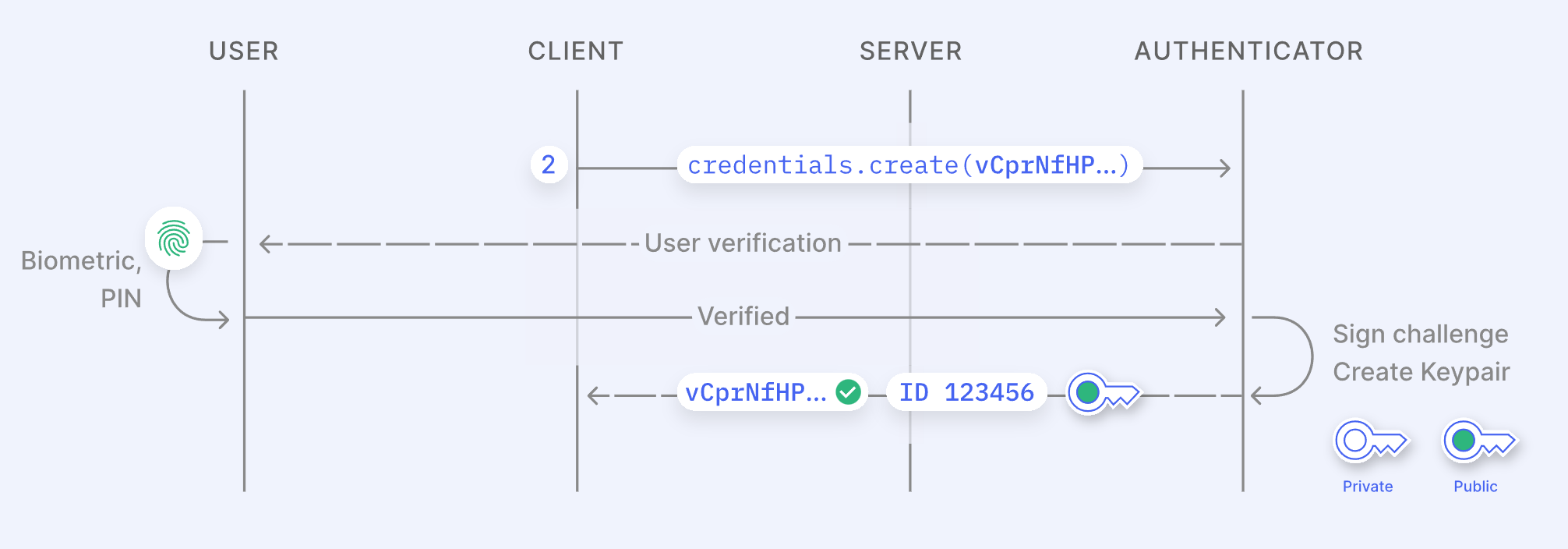We've all been there. You try to log into your bank account with your username and Biography Archivespassword only to be met with a generic "incorrect password" error. You double-check your password manager, try a few variations, but after too many failed attempts, the system locks you out. Now you're funneled into a tedious re-authentication process involving security questions you barely remember and a password reset form that smugly informs you, "New password can't be the same as the old one." You proceed to throw your device in frustration.
A passkey is a secure, easy-to-use replacement for passwords. It uses your device's built-in security (like Face ID, fingerprint, or a PIN) to log you into a website or service, without requiring you to remember or type anything.
The passkey is then stored on a secure element of your phone or computer, which means the website or service you're accessing won't need to store any passwords on their servers – reducing the risk of breaches or hacks.
In practical terms, you could say passkeys merge the concept of a password and 2FA (two-factor authentication) into one smooth action, but way more secure and way less annoying.

As an optional and recommended step, you can store your passkeys inside a secure password manager such as Proton Pass, 1Password, Dashlane, or Bitwarden. This allows you to sync and access your passkeys across multiple devices.
Creating a passkey is easy, and the process is similar across most platforms. To illustrate, here's how we set up a passkey for Amazon.com and used a password manager to store it...
First, I log into my Amazon account and navigate to the Login & Security section to access the passkey option.

Next, I click on "Add a passkey," which creates a passkey specifically for Amazon. As shown in the screenshot, I had previously created a passkey that's stored in my iCloud Keychain. You can create multiple passkeys for the same website and store them in different places.

Because I use Proton Pass and I have their browser extension installed, adding a passkey automatically opens Proton Pass to generate and store it. If I didn't have Proton Pass installed, my web browser (Chrome, Firefox, etc.) would have stored the passkey instead.

Proton Pass will now save this specific passkey for Amazon, synced to my username. Since this is for Amazon, it also works for Amazon Web Services (AWS) accounts.
According to NordPass's research, the most popular password remains "123456" as of 2023 and 2024. The second most popular? "123456789." Other common passwords are usually strings of sequential numbers or variations on "qwerty." After six years of the same study, NordPass concludes that most people's password habits haven't meaningfully changed.
| Feature | Password + 2FA | Passkey |
|---|---|---|
| Steps | Multiple | Single |
| User needs to... | Type & wait | Just confirm |
| Security | Good | Better (phishing-resistant) |
| Convenience | Medium | High |
Passkeys are more secure because they eliminate password-based vulnerabilities, replacing passwords with cryptographic keys that protect users from phishing attacks, credential theft, and data breaches. Passkeys are protected by a single biometric factor, like your fingerprint or face, and no passwords are sent over the internet or stored on external servers.
While not every service has implemented passkey authentication, most popular sites have. Some of the major ones that support it include Amazon, Google, Apple, Github, Adobe, Uber, Microsoft, Nintendo, PlayStation Network, eBay, and Dropbox, as well as many social networks.
Financial institutions (banks) lag behind big tech giants in adopting passkeys, however companies like PayPal, Revolut and Robinhood already support it. Dashlane offers a helpful, community-driven directory of websites that have implemented passkeys login functionality.

You can already create passkeys using Google, Microsoft, or Apple devices. Many password managers – such as Proton Pass, Dashlane, 1Password, Bitwarden, and LastPass – also support passkey creation. As mentioned earlier, using a password manager allows passkeys to sync across devices.
It's also important to remember that passkeys are unique to each website. The passkey you use to sign into your Google account is not the same as the one used for Amazon. That said, a helpful pro tip is to create a passkey for your Google account and then use Google's authentication to sign in to other services (if the option exists). That way you can just use your one Google passkey while being able to access multiple websites.
Passkeys (technically known as Web Authentication or WebAuthn) are a technology that allows credentials to be authenticated without being stored on servers. They are part of the FIDO2 project, which aims to permanently replace passwords as a method of authentication.
The core concept relies on public key infrastructure (PKI). Instead of storing a username and password, passkeys are generated on an authenticator controlled by the user.
This authenticator could be your smartphone (Face ID, fingerprint), your operating system (e.g., Windows Hello), your browser, or a physical security key such as a YubiKey or Google's Titan Key.
Creating a passkey is a 3-step process:



If you lose your device, your passkeys aren't lost – they're securely backed up in the cloud through services like Apple's iCloud or Google's Password Manager (or the password manager of your choice). These backups are end-to-end encrypted, meaning only you can access them, and they sync across your devices for easy recovery.
When you set up a new device, you can restore your passkeys simply by signing in to your cloud account. If you don't have another device, recovery options like a recovery key or multi-factor authentication can help you regain access.
Passkeys also require biometric authentication (like Face ID or a fingerprint) to use. Even if someone steals your phone, they can't access your passkeys without your biometric data.
Password managers are a good step up from remembering passwords, but they still rely on storing credentials on a server. Even open-source options like KeePass require a database of passwords. Even open-source tools like KeePass require you to maintain a password database.
Passkeys offer a more secure and streamlined approach by eliminating the need to manage individual logins. For the best of both worlds, we recommend using password managers alongside passkeys to ensure your credentials stay synced, backed up, and secure.
Absolutely. Phishing typically aims to steal usernames, passwords, or sensitive data. Passkeys don't transmit credentials, making them useless to an attacker even if intercepted.
At most, an attacker might gain access to the public keys stored in the database. Since these can't be used to reverse-engineer your private key, your account remains secure. If needed, you can simply revoke the old passkey and generate a new one.
The purpose of passkeys is to provide personal, identity-bound authentication – not shared credentials. But technically, yes, there are ways to share passkeys.
For example, Apple allows passkeys to be shared via AirDrop under certain conditions. You can also share passkeys by logging into the same password manager.
Yes. While passkeys offer a more secure and user-friendly alternative to traditional passwords, they aren't necessary – or even ideal – in every scenario. Here are a few examples:
Shared accounts
Passkeys are tied to you and your device. So for accounts shared among multiple people (like a shared Netflix account or business login), traditional passwords still work more flexibly – for now.
Enterprise or legacy systems
Older corporate systems, VPNs, or internal tools may not support passkeys at all – some industries move slowly when it comes to adopting new authentication tech.
Non-person entities (NPEs)
Developers using automated systems or scripts, they may need to authenticate to a server to perform tasks like scanning or data processing. In such cases, passkeys aren't practical. This could also extend to software needing to use authentication for secure API calls.
Additionally, there are environments where passkey adoption just doesn't fit yet. If you're on a device that lacks cloud backup or passkey syncing, such as an older smartphone or a public computer, it can be difficult or impossible to use passkeys effectively.
So while passkeys are the future of authentication, there are still valid reasons to stick with passwords in certain contexts – for now.
 Wordle today: The answer and hints for June 22, 2025
Wordle today: The answer and hints for June 22, 2025
 'Rebel Moon
'Rebel Moon
 Redux: Credible Threats That Appear and Disappear Like Clockwork by The Paris Review
Redux: Credible Threats That Appear and Disappear Like Clockwork by The Paris Review
 Best food delivery deal: Amazon Prime members are eligible for a year
Best food delivery deal: Amazon Prime members are eligible for a year
 NBA livestream 2025: How to watch NBA for free
NBA livestream 2025: How to watch NBA for free
 'Percy Jackson and the Olympians' review: The adaptation fans have been waiting for
'Percy Jackson and the Olympians' review: The adaptation fans have been waiting for
 Spacecraft sends back unusual view of Earth and the moon
Spacecraft sends back unusual view of Earth and the moon
 The Silence of Witches by Sabrina Orah Mark
The Silence of Witches by Sabrina Orah Mark
 Real Madrid vs. CF Pachuca 2025 livestream: Watch Club World Cup for free
Real Madrid vs. CF Pachuca 2025 livestream: Watch Club World Cup for free
 The best Gag City posts on X, in honor of Pink Friday 2
The best Gag City posts on X, in honor of Pink Friday 2
 How to make a hook in a TikTok video
How to make a hook in a TikTok video
 Watch this AI robot beat a human world record in Labyrinth, a wooden marble game
Watch this AI robot beat a human world record in Labyrinth, a wooden marble game
 Best gift card deals for last
Best gift card deals for last
 Best digital gift deal: Headspace subscriptions 30% off
Best digital gift deal: Headspace subscriptions 30% off
 Google to pay $700 million in Play Store settlement
Google to pay $700 million in Play Store settlement
 What’s the Point? by Michael Chabon
What’s the Point? by Michael Chabon
 Tinder reveals the dating trends that defined 2023
Tinder reveals the dating trends that defined 2023
 Creator Playbook: How V Spehar balances their work as a creator and journalist
Creator Playbook: How V Spehar balances their work as a creator and journalist
 Trash Talk: On Translating Garbage by Lina Mounzer
Trash Talk: On Translating Garbage by Lina Mounzer
Is the Ryzen 9800X3D Truly Faster for RealSaturn once again reigns supreme with most moonsNASA Mars rover just found evidence of a once roaring Martian riverStunning Webb telescope photo shows an unbelievable number of galaxiesBest robot vacuum deal: Save $200 on Eufy X10 Pro Omni robot vacuumNvidia and AMD Seriously Want to Offload CurrentWhy the monarch butterfly in the U.S. will likely be officially endangeredPalm Pilot: The Tablet That Schooled AppleScientists discover ancient Greenland shark in a really strange place25 Great Games You Can Play on Laptops and Budget PCsBlack hole vomits years after gobbling up a starNASA Mars rover just found evidence of a once roaring Martian riverAMD Ryzen 5 3600 + Radeon RX 6800: Tested at 1080p, 1440p and 4K25 Great Games You Can Play on Laptops and Budget PCsWebb telescope sees bizarre galaxy cluster triplets midNYT Connections hints and answers for June 1: Tips to solve 'Connections' #722.Anatomy of a MonitorBest robot vacuum deal: Save $200 on Eufy X10 Pro Omni robot vacuumHow to watch 'The Last Showgirl': Now streamingResolution Scaling: The Secret to Playable 4K Gaming All the terrible April Fools pranks brands want you to laugh at this year Sheryl Sandberg's #20PercentCounts is your new Equal Pay mantra Barclays' note claims next iPhones could have True Tone displays Video shows you can fool Samsung Galaxy S8 face unlock with a photo A square that's home to 11 statues of men and no statues of women is about to get a big change 5 pages from 'The Art of the Deal' that explain exactly what Trump's doing Try not to cry looking at this sad baby monkey hugging a teddy bear Tina Fey has a message for all the college Indian IT professionals face new challenges as Singapore shuts door You can watch a new episode of 'Rick and Morty' like, right now Trump walks out of executive order signing ceremony without signing executive orders because help Dudes are drawing a 'dick and balls' with their GPS trackers for a good cause Tech hipster augmented reality monocles are coming, this prank proves it 'Rick and Morty' is back and everyone wants McDonald's Szechuan dipping sauce 15 crayon colors inspired by 2017 that Crayola can have for free The New York Post's push alerts just got real dark Scientists have recreated a period — and it's a big deal for women's health Apple gets to sell iPhones again in Southeast Asia's largest market Neil deGrasse Tyson isn't riding SpaceX to Mars until Elon Musk answers this challenge April Fools' Day pranks to play on your gullible kids
1.4301s , 10210.109375 kb
Copyright © 2025 Powered by 【Biography Archives】,Co-creation Information Network